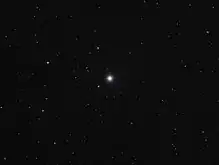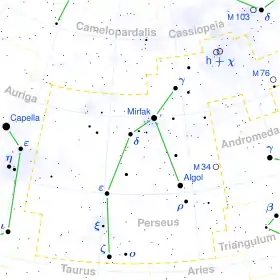Iota Persei
ι Persei, Latinized as Iota Persei, is a single[12] star in the northern constellation Perseus. This object is visible to the naked eye as a faint, yellow-white hued point of light with an apparent visual magnitude of 4.1.[2] It is located 34 light years from the Sun based on parallax,[1] and is drifting further away with a radial velocity of +49 km/s.[5] Iota Persei has a relatively high proper motion across the sky.[1]

 | |
| Observation data Epoch J2000 Equinox J2000 | |
|---|---|
| Constellation | Perseus |
| Right ascension | 03h 09m 04.02s[1] |
| Declination | +49° 36′ 47.8″[1] |
| Apparent magnitude (V) | 4.062[2] |
| Characteristics | |
| Spectral type | G0V[3] or F9.5 V[4] |
| U−B color index | +0.119[2] |
| B−V color index | +0.595[2] |
| Astrometry | |
| Radial velocity (Rv) | +49.22±0.08[5] km/s |
| Proper motion (μ) | RA: +1262.41[1] mas/yr Dec.: –91.50[1] mas/yr |
| Parallax (π) | 94.87 ± 0.23[1] mas |
| Distance | 34.38 ± 0.08 ly (10.54 ± 0.03 pc) |
| Absolute magnitude (MV) | 3.94[6] |
| Details | |
| Mass | 1.35±0.08[7] M☉ |
| Radius | 1.412±0.009[8] R☉ |
| Luminosity | 2.181±0.032[8] L☉ |
| Surface gravity (log g) | 4.31[7] cgs |
| Temperature | 5,963±5.1[9] K |
| Metallicity [Fe/H] | +0.09[10] dex |
| Rotational velocity (v sin i) | 4.1[7] km/s |
| Age | 3.2–4.1[7][10] Gyr |
| Other designations | |
| Database references | |
| SIMBAD | data |
This is a late F- or early G-type main-sequence star with a stellar classification of around G0V.[3] It is about 3–4[7][10] billion years old and is spinning slowly with a projected rotational velocity of 4 km/s.[7] The star has 1.4[7] times the mass of the Sun and 1.4[8] times the Sun's radius. It is radiating more than double[8] the luminosity of the Sun from its photosphere at an effective temperature of 5,963 K.[9]
There is a 12.4-magnitude line-of-sight companion star that is not believed to be gravitationally associated with Iota Persei.[12] This object is located at an angular separation of 154.4″ from the primary along a position angle of 125°, as of 2014.[13]
Naming
In Chinese, 大陵 (Dà Líng), meaning Mausoleum, refers to an asterism consisting of ι Persei, 9 Persei, τ Persei, κ Persei, β Persei, ρ Persei, 16 Persei and 12 Persei. Consequently, the Chinese name for ι Persei itself is 大陵三 (Dà Líng sān, English: the Third Star of Mausoleum).[14]
See also
References
- van Leeuwen, F. (2007). "Validation of the new Hipparcos reduction". Astronomy and Astrophysics. 474 (2): 653–664. arXiv:0708.1752. Bibcode:2007A&A...474..653V. doi:10.1051/0004-6361:20078357. Vizier catalog entry
- Jennens, P. A.; Helfer, H. L. (September 1975), "A new photometric metal abundance and luminosity calibration for field G and K giants", Monthly Notices of the Royal Astronomical Society, 172: 667–679, Bibcode:1975MNRAS.172..667J, doi:10.1093/mnras/172.3.667.
- Keenan, Philip C.; McNeil, Raymond C. (1989), "The Perkins catalog of revised MK types for the cooler stars", The Astrophysical Journal Supplement Series, 71: 245, Bibcode:1989ApJS...71..245K, doi:10.1086/191373
- Gray, R. O.; et al. (July 2006), "Contributions to the Nearby Stars (NStars) Project: spectroscopy of stars earlier than M0 within 40 pc-The Southern Sample", The Astronomical Journal, 132 (1): 161–170, arXiv:astro-ph/0603770, Bibcode:2006AJ....132..161G, doi:10.1086/504637.
- Nidever, David L.; et al. (August 2002), "Radial Velocities for 889 Late-Type Stars", The Astrophysical Journal Supplement Series, 141 (2): 503–522, arXiv:astro-ph/0112477, Bibcode:2002ApJS..141..503N, doi:10.1086/340570.
- Holmberg, J.; et al. (July 2009), "The Geneva-Copenhagen survey of the solar neighbourhood. III. Improved distances, ages, and kinematics", Astronomy and Astrophysics, 501 (3): 941–947, arXiv:0811.3982, Bibcode:2009A&A...501..941H, doi:10.1051/0004-6361/200811191.
- Valenti, Jeff A.; Fischer, Debra A. (July 2005). "Spectroscopic Properties of Cool Stars (SPOCS). I. 1040 F, G, and K Dwarfs from Keck, Lick, and AAT Planet Search Programs". The Astrophysical Journal Supplement Series. 159 (1): 141–166. Bibcode:2005ApJS..159..141V. doi:10.1086/430500. Note: see VizieR catalogie J/ApJS/159/141.
- Boyajian, Tabetha S.; et al. (February 2012), "Stellar Diameters and Temperatures. I. Main-sequence A, F, and G Stars", The Astrophysical Journal, 746 (1): 101, arXiv:1112.3316, Bibcode:2012ApJ...746..101B, doi:10.1088/0004-637X/746/1/101. See Table 10.
- Kovtyukh, V. V.; et al. (2003). "High precision effective temperatures for 181 F-K dwarfs from line-depth ratios". Astronomy and Astrophysics. 411 (3): 559–564. arXiv:astro-ph/0308429. Bibcode:2003A&A...411..559K. doi:10.1051/0004-6361:20031378.
- Mamajek, Eric E.; Hillenbrand, Lynne A. (November 2008). "Improved Age Estimation for Solar-Type Dwarfs Using Activity-Rotation Diagnostics". The Astrophysical Journal. 687 (2): 1264–1293. arXiv:0807.1686. Bibcode:2008ApJ...687.1264M. doi:10.1086/591785.
- "iot Per". SIMBAD. Centre de données astronomiques de Strasbourg. Retrieved 2019-08-06.
- Eggleton, P. P.; Tokovinin, A. A. (September 2008), "A catalogue of multiplicity among bright stellar systems", Monthly Notices of the Royal Astronomical Society, 389 (2): 869–879, arXiv:0806.2878, Bibcode:2008MNRAS.389..869E, doi:10.1111/j.1365-2966.2008.13596.x.
- Mason, B. D.; et al. (2014), The Washington Visual Double Star Catalog, Bibcode:2001AJ....122.3466M, doi:10.1086/323920
- (in Chinese) AEEA (Activities of Exhibition and Education in Astronomy) 天文教育資訊網 2006 年 7 月 11 日
External links
- "Iota Persei". SolStation. Retrieved 2006-07-25.
- "Gl 124". ARICNS. Retrieved 2006-07-25.
- "Iota Per". Prof. Jim Kaler. Retrieved 2006-07-25.
